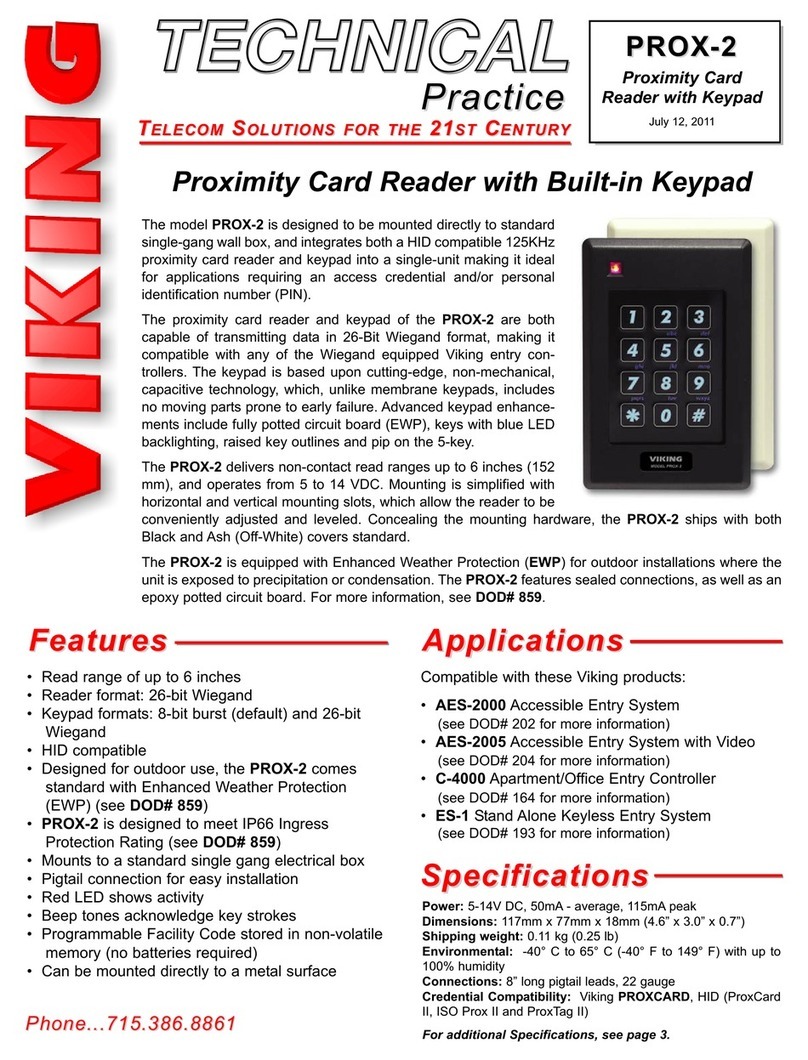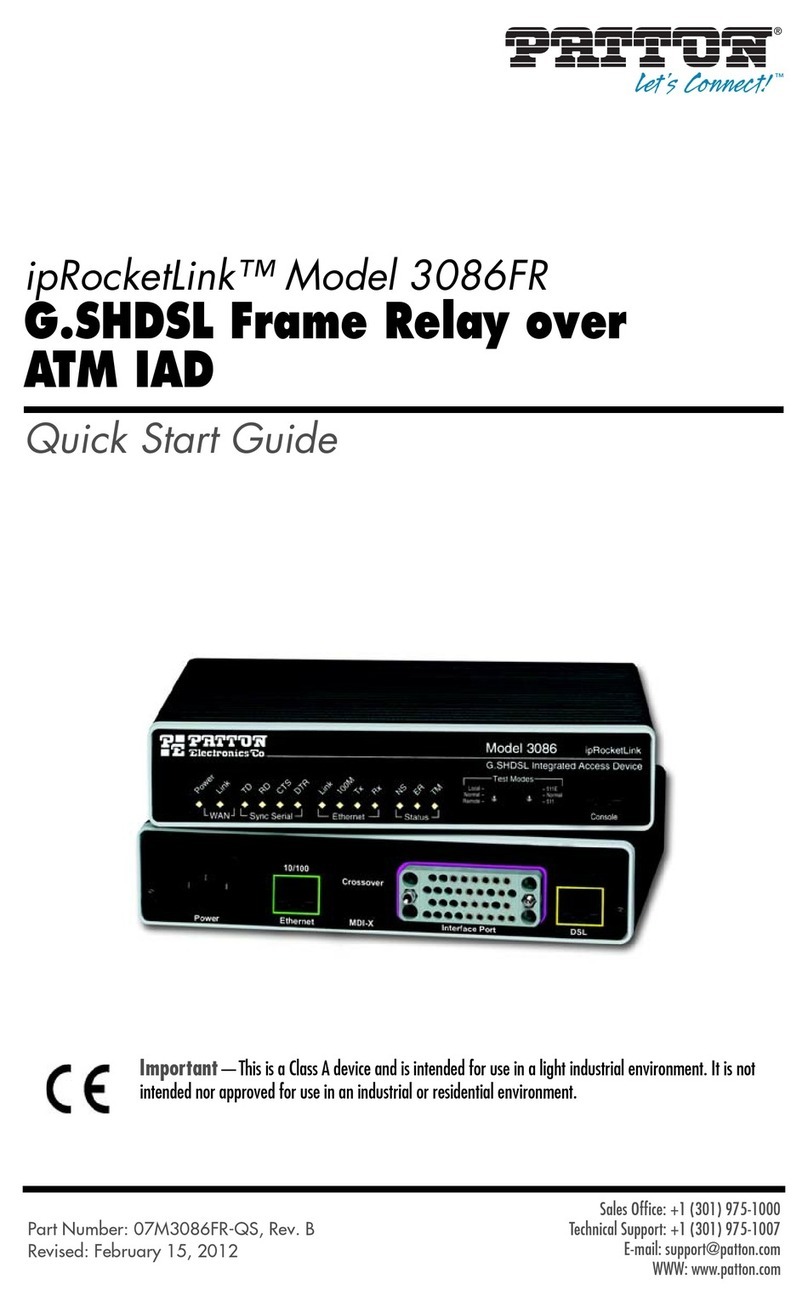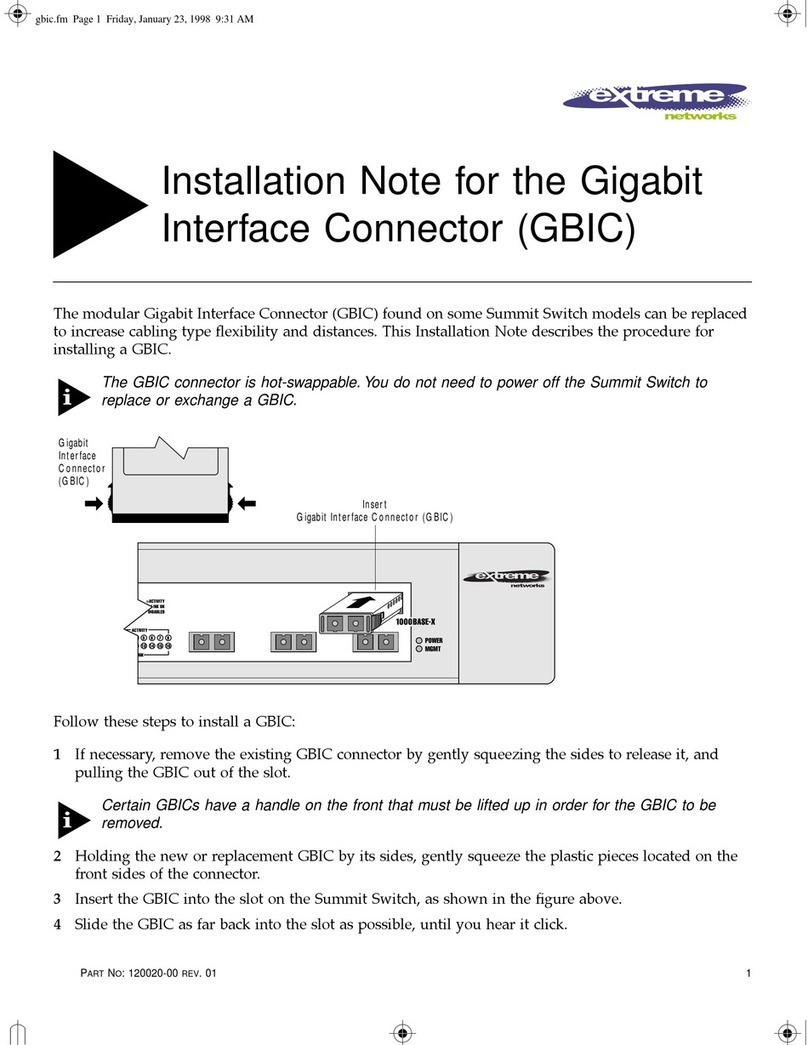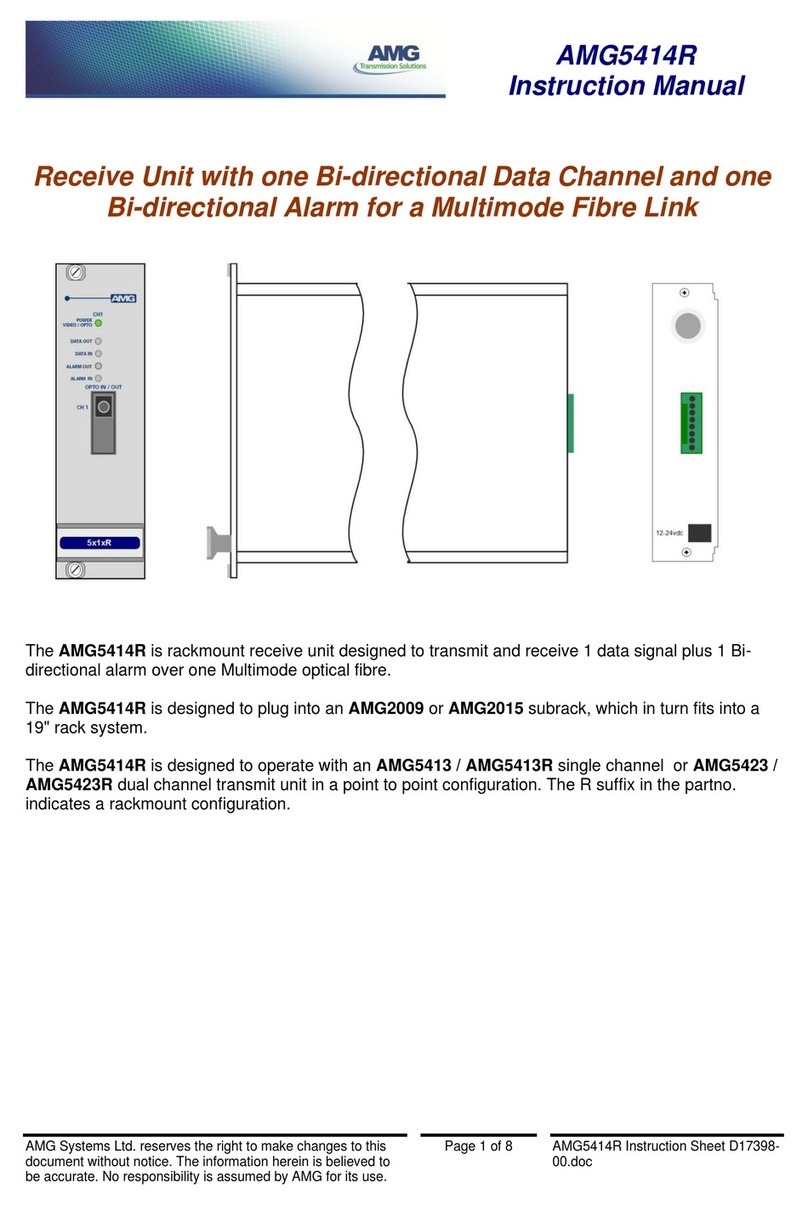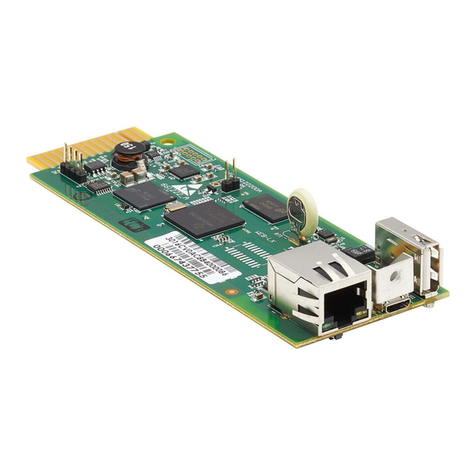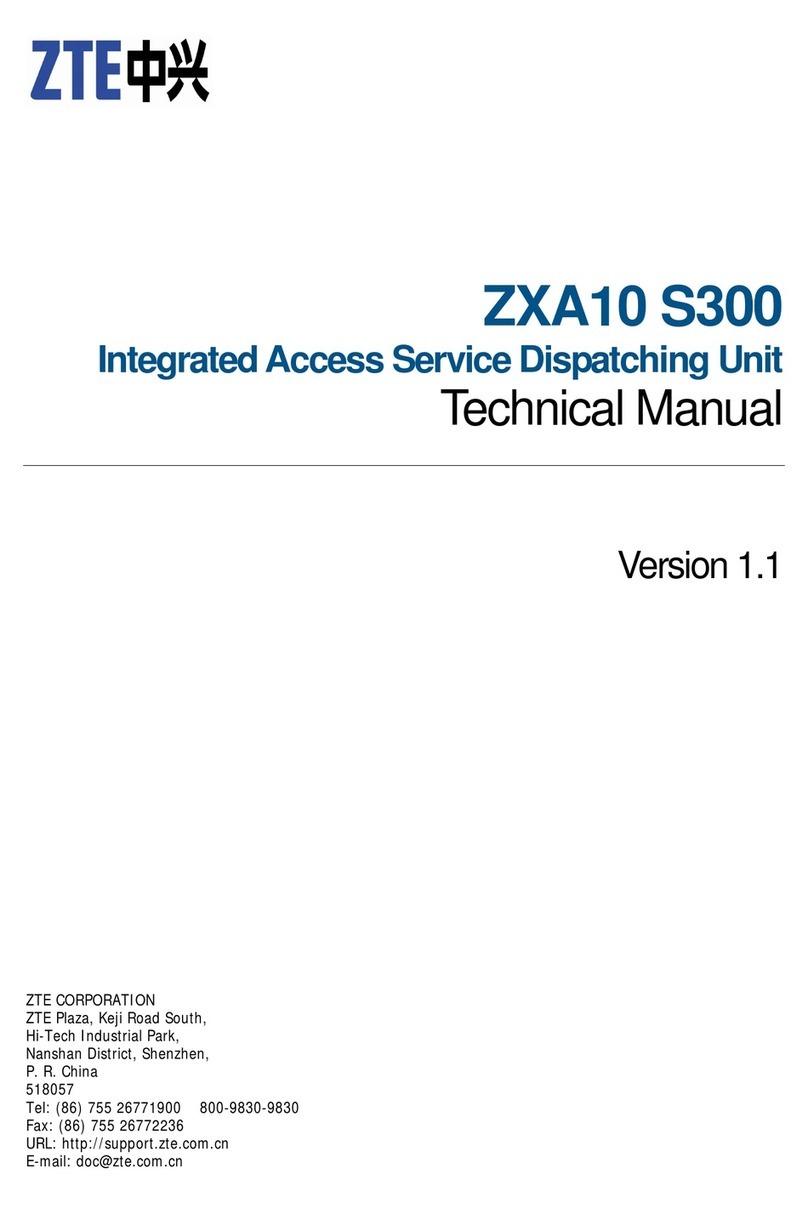Viking PA-250 User manual

Specifications
Information: 715-386-8861
www.VikingElectronics.com
Power: 100V to 240V AC, 50 to 60Hz
Dimensions: approx. 19” x 1.75” x 6” (483mm x 44.5mm x 153mm)
Shipping Weight: 5.2 lbs (2.3 kg)
Environmental: 0°C to 32°C (32°F to 90°F) with 5% to 95%
non-condensing humidity
Talk Battery: 42V DC
Paging Output: Capable of driving 250 Watt load of 70V speakers
Connections: (1) 3.5mm (1/8") audio jack, (22) removable cage clamp
screw terminals, (2) IEC C8 AC power inlets
Power Cord: Dual IEC C7 plugs “Y” power cord included
• Paging systems requiring 8 to 250 speakers
• Paging from virtually any POTS, Centrex PABX, digital or IP phone
system’s analog port
• Installations that can utilize the below advantages of a 70V distributed
audio system:
- Longer wire runs using smaller gauge speaker wire to save costs
- Many speakers can be connected on the same wire run to save costs
- Set each speaker’s volume individually using its own power taps
Applications
The PA-250 is a 250 Watt 70V Telecom Paging Amplifier that
can drive up to two hundred fifty (250) 70V speakers and/or
paging horns (each speaker set to “1 Watt tap”). The small
1U rack size chassis is possible because the PA-250 uses
new amplifier technology that is 3 times more efficient than
old designs competitors use. The high efficiency of the
PA-250 means much less heat dissipation, smaller size,
higher reliability, and lower cost.
There are many advantages of using a 70V distributed audio
paging system, such as being able to put more speakers on
a wire run, having longer speaker wire runs, using smaller
gauge wire, and being able to set the volume of each speaker
independently.
The PA-250 connects to any type of analog telecom
interface, such as a Paging Port, Trunk Input, Analog Station,
FXO (Loop Start), or FXS (Ring Trip).
The PA-250 has a direct microphone input for paging, as well
as other inputs including Background Music, Aux Input, and
a variety of loud ringing and chime options. A 600 Ohm output
allows more paging amplification to be added if needed.
The PA-250 features individual level controls with LED
indicators for each input, automatic peak limiting, multiple
amplifier protection modes, an adjustable Automatic Level
Control, and Bass & Treble controls.
Touch tone programming allows users to set input priorities,
pre-page alert tones, different chime sounds, and numerous
telecom settings for universal telecom system compatibility.
The Aux Input allows the addition of another audio source
such as a clock-controlled tone generator (Viking model
CTG-1A or CTG-2A), or emergency notification system
(Viking model DNA-510).
Add High Power Paging, Loud Ringing, and
Background Music to Any Analog Phone System
PRODUCT
MANUAL
Designed, Manufactured and Supported in the USA PA-250
250 Watt / 70V Telecom
Paging Amplifier
January 4, 2021
SECURITY &
COMMUNICATION
VIKING
• Powerful 70V amplifier drives up to 250 Watt load
• Page from any analog telecom port or a direct microphone
• Auxiliary and background music inputs
• Individual and master volume controls
• Bass and treble controls
• LEDs show audio level and activity
• Programmable input priorities
• Choose between 3 different chime sounds
• Provides Loud Ringing / Night Bell
• Night Transfer switch input
• 600 Ohm output to drive additional amplifiers
• Adjustable Automatic Level Control
• Peak limiter and multiple protection modes
• Tamper resistant trim pots
• Disconnects on silence, CPC, busy, return to dial tone or time-out
Features

2
Features Overview
IMPORTANT: Electronic devices are susceptible to lightning and power station electrical surges from both the AC outlet
and the telephone line. It is recommended that a surge protector be installed to protect against such surges.
PA-250 Front View
MIC: Microphone Input volume control and LED showing audio input level
ALC: Automatic Level Control adjustment for MIC and PAGE inputs
PAGE: Paging Input volume control and LED showing both activity and audio level
AUX: Auxiliary Input volume control and LED showing both activity and audio level
RING: Volume control and LED indicator for Chime and Loud Ringing tones
MUSIC: Volume control for Background Music Input
BASS: Low frequency tone control
TREBLE: High frequency tone control
MASTER VOLUME: Master volume control and LED level indicator for setting Peak Limiting
POWER: LED indicating power is on (winks off to indicate an overload condition)
250 Watt Telecom Paging Amplifier
MIC ALC AUXPAGE RING BASS
MASTER
VOLUMETREBLE
POWER
MUSIC
VIKING
MODEL PA-250
PA-250 Back View
FXO (LOOP START)
FXS (RING TRIP)
PAGE PORT
PROG
MICROPHONE
SPEAKERS
PAGE
CONTACT
PAGE
INPUT
MIC IN
BACKGROUND
MUSIC INPUT
SHIELD
PTT
AC POWER INPUT
(BOTH REQUIRED)
+
+
SHIELD
AUX
INPUT
RINGING
LINE IN
25V
70V
25V
CHIME TRIG
NIGHT
XFER
600 OHM
OUTPUT
1 2 3 4 5 6 7 8 9 10 11 12 13 14 15 16 17 18 19 20 21 22
+ ++
LOUD
RING
MODEL PA-250
VIKING
250 WATT TELECOM PAGING AMPLIFIER
CHIME TRIG: To trigger one of three different chime tones
NIGHT TRANSFER: To enable (open), or disable (closed) loud ringing
RINGING LINE: A ringing FXS or PABX analog station will trigger loud ringing
BACKGROUND MUSIC INPUT: 3.5mm jack for connecting music source
600 OHM OUTPUT: Output for driving additional amplifiers
SHIELD:
Analog ground. Connect to earth ground if audible hum or crosstalk is observed
AUX INPUT: Auxiliary analog input
PAGE CONTACT: Contact closure input for telecom paging
PAGE INPUT: Analog input for telecom paging
PROG: Push button to access programming mode without security code
FXO/FXS/PAGE PORT: Slide switches for FXO (Loop Start), FXS (Ring
Trip), or Page Port telecom paging
PTT: Push-to-Talk input for microphone
MIC IN: Low level dynamic microphone input
AC POWER INPUT:
Connect to 100V to 240V AC
power using the included
“Y” power cord
SPEAKERS: Connect up
to two hundred fifty (250)
70V or 25V speakers and/or
paging horns
Use included slotted bit to adjust tamper resistant front panel pots.

3
Installation
A. Microphone Loud Paging
B. Telecom Loud Paging
Step 1 Connect a balanced low impedance microphone to the MIC IN terminals (pins 1& 2).
Step 2 Connect the microphone’s shield wire to the SHIELD terminal (pin 3).
Step 3 Connect the microphone’s Push-to-Talk leads (if available) to the PTT terminals (pins 3 & 4).
Step 4
If the microphone does not have Push-to-Talk, the MIC VOX CONTROL feature must be enabled (enter
1#42 in programming). The VOX Silence Time Out feature will end the page after 3 seconds of silence,
but is programmable from 1 - 9 seconds. See Programming section.
Step 5 Adjust the front panel MIC trim pot so the MIC LED flashes with mic audio.
FXO (LOOP START)
FXS (RING TRIP)
PAGE PORT
PROG
MICROPHONE
PAGE
CONTACT
PAGE
INPUT
MIC IN
SHIELD
PTT
1 2 3 4 5 6 7 8
++
MIC + (WHITE)
MIC -- (GREEN)
SHIELD
PUSH TO TALK (BLACK)
PUSH TO TALK (RED)
PA-250 Back Panel
Shure Model 522
Base-Station
Microphone
with switch set to
“Low Impedance”
(not included)
Step 1 Move both back panel slide switches to the FXO (LOOP START) position.
Step 2 Connect the phone system’s Trunk Port / FXO / or an analog phone to the PAGE INPUT terminals
(pins 5& 6).
Step 3 Adjust the front panel PAGE trim pot so the PAGE LED flashes with page audio.
1. FXO (Loop Start) for Line Input (Trunk Port) or Analog Phone
PA-250 Back Panel
FXO FXO
OR
FXO (LOOP START)
FXS (RING TRIP)
PAGE PORT
PROG
MICROPHONE
PAGE
CONTACT
PAGE
INPUT
MIC IN
SHIELD
PTT
1 2 3 4 5 6 7 8
++
Analog
Phone
Unused Telephone Line
Input (Trunk Port) or FXO

4
Step 1 Move both back panel slide switches to the PAGING PORT position.
Step 2 Connect the phone system’s Paging Port output to the PAGE INPUT terminals (pins 5& 6).
Step 3 Connect the phone system’s paging contacts (if available) to the PAGE CONTACT terminals (pins 7
& 8).
Step 4
If paging contacts are not available, the PAGE VOX CONTROL feature must be enabled (enter
1#43 in programming). The VOX Silence Time Out feature will end the page after 3 seconds of
silence, but is programmable from 1 - 9 seconds. See Programming section.
Step 5 Adjust the front panel PAGE trim pot so the PAGE LED flashes with page audio.
Step 6
If the Page Port audio is coming from an RCA jack, and hum or buzz is present in the audio, the
RCA cable’s shield may need to be grounded on the PA-250 side. This can be done by connecting
the cable’s shield to the Ground Terminal (pin 7).
Step 1 Move both back panel slide switches to the FXS (RING TRIP) position.
Step 2 Connect an Analog Station / FXS / or Ringing Line to the PAGE INPUT terminals (pins 5& 6).
Step 3 Adjust the front panel PAGE trim pot so the PAGE LED flashes with page audio.
Step 4 Program the Page Time Out, Silence Time Out, Busy Detect, and Return to Dial Tone Detect
features to best suit your Telecom Systems’s functionality.
3. Paging Port
2. FXS (Ring Trip) for Use with an Analog Station
PA-250 Back Panel
FXSEARTH
GROUND
FXS
FXO (LOOP START)
FXS (RING TRIP)
PAGE PORT
PROG
MICROPHONE
PAGE
CONTACT
PAGE
INPUT
MIC IN
SHIELD
PTT
1 2 3 4 5 6 7 8
++
Analog PABX Extension,
Centrex Line or FXS
Paging Port Page Contact
(if available)
PA-250 Back Panel
PAGE
PORT
PAGE
PORT
FXO (LOOP START)
FXS (RING TRIP)
PAGE PORT
PROG
MICROPHONE
PAGE
CONTACT
PAGE
INPUT
MIC IN
SHIELD
PTT
1 2 3 4 5 6 7 8
++
NOTE:
1. Connect earth ground to a shield terminal (3,7 or 11) to prevent noise during FXS pages.
2. Dialing ”#7” forces the PA-250 to hang up but the #7 touch tones will be heard over the speakers.

5
Step 1 Connect any line level source to the AUX IN terminals (pins 9& 10)
Step 2
Adjust the front panel AUX trim pot so the AUX LED flashes with Aux audio. If AUX audio sounds
distorted, its input is probably being overdriven. Turn down the front panel AUX trim pot until the sound
is clear. The VOX Silence Time Out feature will end the page after 3 seconds of silence, but is
programmable from 1 - 9 seconds.
Step 3
If the auxiliary audio is coming from an RCA jack, and hum or buzz is present in the audio, the RCA cable
shield may need to be grounded on the PA-250 side. This can be done by connecting the cable shield
to the SHIELD terminal (pin 11).
C. Auxiliary Input
NOTE: A speaker level signal can be connected to the AUX IN terminals, as long as the front panel AUX trim pot is turned down low
enough to not overdrive the input.
Also available:
Model MTG-10
Product Manual: DOD 482
Model CTG-1A
Product Manual: DOD 461
Model DNA-510
Product Manual: DOD 492
PA-250 Back Panel
FXO (LOOP START)
FXS (RING TRIP)
PAGE PORT
PROG
MICROPHONE
PAGE
CONTACT
PAGE
INPUT
MIC IN
BACKGROUND
MUSIC INPUT
SHIELD
PTT
+
SHIELD
AUX
INPUT
RINGING
LINE IN
600 OHM
OUTPUT
1 2 3 4 5 6 7 8 9 10 11 12 13
+ ++
Any Line Level Source
Model CTG-2A shown (not included)
See Product Manual: DOD 464.
See
Pr
odu
ct
Man
ual
: D
OD
464
.
Step 1 Connect the PA-250’s 600 OHM OUTPUT terminals (pins 12 & 13), to the PP-250’s LINE INPUT
terminals (pins 1& 2).
Step 2 If a shield cable is used, connect the cable’s shield at both ends.
Step 3 Adjust the PP-250’s front panel INPUT trim pot so the LED flashes with page audio.
D. 600 Ohm Output for Additional Paging Power
When more than a 250 Watt load is required, a Viking model PP-250 can be added to achieve a 500 Watt load capability.
FXO (LOOP START)
FXS (RING TRIP)
PAGE PORT
PROG
MICROPHONE
SPEAKERS
PAGE
CONTACT
PAGE
INPUT
MIC IN
BACKGROUND
MUSIC INPUT
SHIELD
PTT
++
SHIELD
AUX
INPUT
RINGING
LINE IN
25V
70V
25V
CHIME TRIG
NIGHT
XFER
600 OHM
OUTPUT
1 2 3 4 5 6 7 8 9 10 11 12 13 14 15 16 17 18 19 20 21 22
+ ++
LOUD
RING
PA-250 Back Panel
PP-250 Back Panel
FXO (LOOP START)
FXS (RING TRIP)
PAGE PORT
PROG
MICROPHONE
SPEAKERS
PAGE
CONTACT
PAGE
INPUT
MIC IN
BACKGROUND
MUSIC INPUT
SHIELD
PTT
++
SHIELD
AUX
INPUT
RINGING
LINE IN
25V
70V
25V
CHIME TRIG
NIGHT
XFER
600 OHM
OUTPUT
1 2 3 4 5 6 7 8 9 10 11 12 13 14 15 16 17 18 19 20 21 22
+ ++
LOUD
RING
SPEAKERS
++
SPEAKERS+
25V
70V
25V
4 5 6 7
+
MODEL PP-250
VIKING
250 WATT PAGING POWER AMPLIFIER
LINE INPUT
1 2 3
Model PP-250 shown (not included)
See Product Manual: DOD 511.

6
Step 1 Connect background music source to BACKGROUND MUSIC INPUT jack using a 1/8” (3.5mm) cable.
Step 2 Adjust the front panel music trim pot to the desired level.
E. Background Music Input
NOTE: Background music will play only when all other audio inputs are idle.
FXO (LOOP START)
FXS (RING TRIP)
PAGE PORT
PROG
MICROPHONE
SPEAKERS
PAGE
CONTACT
PAGE
INPUT
MIC IN
BACKGROUND
MUSIC INPUT
SHIELD
PTT
++
SHIELD
AUX
INPUT
RINGING
LINE IN
25V
70V
25V
CHIME TRIG
NIGHT
XFER
600 OHM
OUTPUT
1 2 3 4 5 6 7 8 9 10 11 12 13 14 15 16 17 18 19 20 21 22
+ ++
LOUD
RING
PA-250 Back Panel
Background Music
Source (not included)
3.5 mm mono cable
(not included)
Step 1 Connect a ringing line, FXS Port or ringing Analog PABX Station to the RINGING LINE IN terminals
(pins 14 & 15).
Step 2 A Night Transfer switch may be added to the NIGHT XFER terminals (pins 16 & 17) to enable and
disable loud ringing.
Step 3 The front panel RING trim pot can be used to adjust ringing and chime tone volumes.
F. Loud Ringing / Night Transfer
1. Ringing Analog Line
FXO (LOOP START)
FXS (RING TRIP)
PAGE PORT
PROG
MICROPHONE
SPEAKERS
PAGE
CONTACT
PAGE
INPUT
MIC IN
BACKGROUND
MUSIC INPUT
SHIELD
PTT
++
SHIELD
AUX
INPUT
RINGING
LINE IN
25V
70V
25V
CHIME TRIG
NIGHT
XFER
600 OHM
OUTPUT
1 2 3 4 5 6 7 8 9 10 11 12 13 14 15 16 17 18 19 20 21 22
+ ++
LOUD
RING
PA-250 Back Panel
Ringing Line,
FXS or
PABX Station
Optional Night Transfer Switch
Disables loud ringing when
closed. Use Viking Model NS-1
(not included, DOD 540).

7
Step 1 Connect a phone system’s common audible dry contact closure to the CHIME TRIG terminals (pins
17 & 18).
Step 2 Chime Trigger is factory set to the “Door Chime” (dingong) sound, but can be programed to the
“Electronic Warble” sound (see Programming section K).
Step 3 The front panel RING trim pot can be used to adjust ringing, chime tones, and alert tone volumes.
2. Using the Chime Trigger Input for a Dry Contact (Common Audible) Closure from the Phone System
FXO (LOOP START)
FXS (RING TRIP)
PAGE PORT
PROG
MICROPHONE
SPEAKERS
PAGE
CONTACT
PAGE
INPUT
MIC IN
BACKGROUND
MUSIC INPUT
SHIELD
PTT
++
SHIELD
AUX
INPUT
RINGING
LINE IN
25V
70V
25V
CHIME TRIG
NIGHT
XFER
600 OHM
OUTPUT
1 2 3 4 5 6 7 8 9 10 11 12 13 14 15 16 17 18 19 20 21 22
+ ++
LOUD
RING
PA-250 Back Panel
Common Audible
Dry Contact Closure
Step 1 Connect any momentary contact closure (such as a non-lighted door bell button) to the CHIME TRIG
terminals (pins 17 & 18).
Step 2 A momentary closure will trigger a “Door Chime” (ding-dong) tone, but can be programed to one of three
other sounds (see Programming section K).
Step 3 The front panel RING trim pot can be used to adjust ringing, chime tones, and alert tone volumes.
G. Chime Trigger
FXO (LOOP START)
FXS (RING TRIP)
PAGE PORT
PROG
MICROPHONE
SPEAKERS
PAGE
CONTACT
PAGE
INPUT
MIC IN
BACKGROUND
MUSIC INPUT
SHIELD
PTT
++
SHIELD
AUX
INPUT
RINGING
LINE IN
25V
70V
25V
CHIME TRIG
NIGHT
XFER
600 OHM
OUTPUT
1 2 3 4 5 6 7 8 9 10 11 12 13 14 15 16 17 18 19 20 21 22
+ ++
LOUD
RING
PA-250 Back Panel
Momentary
Switch Button
(not included)

8
H. Speakers
Step 1 Connect 70V speakers across the 70V SPEAKERS terminals (pins 19 & 22).
Step 2 If using 25V speakers, connect half of them across the 25V SPEAKERS terminals (pins 19 & 20), and the other half
across the 25V SPEAKERS terminals (pins 21 & 22), so that the power load is balanced between the two outputs.
Step 3
Check the power tap of each speaker connected, and be sure the sum of all the speakers connected does not
exceed 250 Watts. For example, if there are 40 speakers, and all are wired to their 5 Watt taps, the amplifier is
driving a 200 Watt load. Since the PA-250 is capable of driving a 250 Watt load, additional speakers could be added,
or some of the existing speakers could be tapped at a higher wattage setting to play louder. If the total speaker load
goes “over budget” (greater than 250 Watt load), either remove some speakers, or use lower power taps to get
down to a 250 Watt load. If more than 250 Watt load is needed, a PP-250 can be added as shown in Installation,
section D.
NOTE: For wire run lengths up to 500 feet, use #18 gauge or larger speaker cables. For wire run lengths up to 1000 feet, use #16
gauge or larger speaker cables. For wire run lengths up to 1500 feet, use #14 gauge or larger speaker cables, etc.
FXO (LOOP START)
FXS (RING TRIP)
PAGE PORT
PROG
MICROPHONE
SPEAKERS
PAGE
CONTACT
PAGE
INPUT
MIC IN
BACKGROUND
MUSIC INPUT
SHIELD
PTT
++
SHIELD
AUX
INPUT
RINGING
LINE IN
25V
70V
25V
CHIME TRIG
NIGHT
XFER
600 OHM
OUTPUT
1 2 3 4 5 6 7 8 9 10 11 12 13 14 15 16 17 18 19 20 21 22
+ ++
LOUD
RING
PA-250 Back Panel
Up to
250W
Load
70V Paging Speakers
25AE-70V Paging Horns shown
(not included, see DOD 471)
30AE-70V Speakers shown
(not included, see DOD 473)
Step 1 Connect both IEC C7 plugs from the supplied “Y” AC power cord into the two AC POWER INPUTS on the back of
the PA-250.
Step 2 Once all other connections are made, power up the PA-250 by plugging the AC power plug end of the supplied “Y”
AC power cord into a power outlet.
I. AC Power Input
PA-250 Back Panel
FXO (LOOP START)
FXS (RING TRIP)
PAGE PORT
PROG
MICROPHONE
SPEAKERS
PAGE
CONTACT
PAGE
INPUT
MIC IN
BACKGROUND
MUSIC INPUT
SHIELD
PTT
AC POWER INPUT
(BOTH REQUIRED)
+
+
SHIELD
AUX
INPUT
RINGING
LINE IN
25V
70V
25V
CHIME TRIG
NIGHT
XFER
600 OHM
OUTPUT
1 2 3 4 5 6 7 8 9 10 11 12 13 14 15 16 17 18 19 20 21 22
+ ++
LOUD
RING
MODEL PA-250
VIKING
250 WATT TELECOM PAGING AMPLIFIER
115 VAC
“Y” Power Cord
(included)
Surge
Protector
(not included)
IMPORTANT: Electronic devices
are susceptible to lightning and
power station electrical surges from both
the AC outlet and the telephone line. It is
recommended that a surge protector be
installed to protect against such surges.

9
The PA-250 can be programmed directly from a touch tone phone or butt-set, or from a touch tone phone using a CO
line, PABX analog station (FXS Port), PABX analog trunk input (FXO Port), or a Viking DLE-200B Line Simulator. Since
phone system Paging Ports may not support touch tones, and also may not provide audio in both directions,
programming the PA-250 from a Paging Port is not recommended. For more information on the DLE-200B, see DOD 605.
A. Accessing the Programming Mode
1. Using the Security Code
Step 1 From a touch tone phone, access the PA-250 paging input in either the FXO mode (as shown on
page 3) or FXS mode (as shown on page 4).
Step 2
When the page is made, enter a touch tone “Q” (which will be heard through the paging speakers)
then the 6-digit security code (factory set to 845464, see Progamming section B). A double beep
should be heard indicating you have entered the programming mode.
Programming
2. Without the Security Code
Step 1 With the PA-250 in an idle state, momentarily press the PROG button on the back of the unit using
a small object such as a paperclip.
Step 2 Two beeps can be heard through the paging speakers and the front panel PAGE LED will flash for
20 seconds.
Step 3 During this 20 seconds of time, from a touch tone phone, access the PA-250 paging input in either
the FXO mode (as shown on page 3) or FXS mode (as shown on page 4).
Step 4 A double beep should be heard in the phone indicating you have entered the programming mode.
The security code allows the user/installer to program the PA-250. The factory set security code is 845464 (V-I-K-I-N-G).
It is recommended that the factory set security code be changed.
Example: To store 123456 as the security code:
B. Security Code (Memory Location #47)
NOTE: The security code must be 6 digits and cannot include a “Q
”
or a “#”.
Step 1. Access programming as shown in Programming section A.
Step 2. Enter 123456 #47.
Step 3. Continue programming other settings, or hang-up.

10
Description Enter Digits + Memory
Location
Mic VOX Control (factory set to 0 = OFF) 0 or 1 then #42
Page VOX Control (factory set to 0 = OFF) 0 or 1 then #43
Input Priority (1 to 3, 1 = highest) (factory set to 123) 3 digits* then #44
Access Code (factory cleared, blank = Disabled) 0-6 digits then #45
Security Code (factory set to 845464) 6 digits then #47
Page Time Out (0 to 250 seconds, factory set to 0 = Disabled) 0 to 250 then #48
VOX Silence Time Out (1 to 9 seconds, factory set to 3) 1-9 then #49
Telecom Silence Time Out (0 to 9 seconds, factory set to 0 = Disabled) 0-9 then #50
Chime Tone (1 to 4, factory set to 1 = door chime) 1-4 then #51
Pre-Page Alert Tone = OFF Q0
Pre-Page Alert Tone = ON (factory setting) Q1
Busy Detect = OFF (factory setting) Q4
Busy Detect = ON Q5
Return to Dial Tone Detection = OFF (factory setting) Q6
Return to Dial Tone Detection = ON Q7
Reset all programming to factory default settings ###
Exit programming #7
C. Quick Programming Features
* Inputs in this order: MIC IN (Microphone Input), PAGE INPUT (Telecom Page Input), AUX INPUT (Auxiliary Input).
NOTE: A double beep indicates a valid memory position, three beeps indicate an error.
D. Mic VOX Control
If a microphone that is connected to the MIC INPUT does not have a Push-to-Talk button, the Mic VOX Control feature
should be enabled (enter 1#42 in programming). When enabled, the PA-250 will trigger microphone paging when mic
audio is detected.
NOTE: Pre-Page Alert Tone will not sound even if enabled.
E. Page VOX Control
If a paging port that is connected to the PAGE INPUT does not provide a contact closure for the PAGE CONTACT
connections, the Page VOX Control feature should be enabled (enter 1#43 in programming). When enabled, the PA-250
will trigger telecom paging when paging port audio is detected.
NOTE: Pre-Page Alert Tone will not sound even if enabled.

11
F. Input Priority
Since the PA-250 has MIC, PAGE and AUX audio inputs, priorities are established to prevent contentions between the
three. If multiple inputs are activated at the same time, the one with the highest priority will take effect. When any inputs
share the same priority setting, they are considered “first come first served”. In other words, a second input will not
interrupt a same priority input that is already actively paging.
The PA-250 is factory set with the MIC input set to “1”, which is the highest priority, so it has the ability to interrupt both
the PAGE and AUX audio inputs. The PAGE input is factory set to “2”, and the AUX input is factory set to “3”, the lowest
priority.
Each input can be programmed with a priority level from “1” down to “3”, so there is the ability to arrange any desired
input priority for the Microphone, Telecom Page, and Auxiliary inputs. When in programming, to create a input priority
sequence, enter a three digit string of numbers (followed by #44), that represent the priority level (from 1 to 3) of the
inputs in this order: MIC, PAGE and AUX as shown below.
NOTE: The Background Music input will only be active when no other inputs are active. Loud ringing and Chime Tones will barge in.
Factory Default Setting: 1 + 2 + 3
MIC Priority
PAGE Priority
AUX Priority
Enter Your Priority Settings Here:
M P A
#44
Dial: M + P + A + # + 4 + 4
G. Access Code
When the PAGE INPUT is being used in either the FXO (Loop Start) or FSX (Ring Trip) modes, an Access Code can
been set. When an Access Code is programmed, the incoming pager is prompted with a single beep. The pager is then
required to enter the programmed 1 – 6 digit Access Code. If the proper access code is not entered within 6 seconds,
the PA-250 will triple beep and hang up or give a busy signal. When a valid Access Code has been entered, the PA-250
will allow the page to pass through to the speakers.
To program an Access Code, enter 1-6 digits then #45 in programming.
The PA-250 is factory set with the Access Code disabled, which can be manually done by entering just #45 in
programming.
H. Page Time Out
A maximum page length of 1 to 250 seconds can be programmed for FXO (Loop Start), FXS (Ring Trip), Page Port
using VOX mode, and Mic Page using VOX mode. When programmed, and the Page Time Out length has been met,
the page will be terminated.
To program a Page Time Out, enter 1 - 250 then #48 in programming.
The PA-250 is factory set with the Page Time Out disabled so there is no paging time limit. Page Time Out can be
manually disabled by entering just #48 in programming.
NOTE: Not applicable with Mic paging when PTT is used, Page Port when Contact Closure is used, or the Aux Input.
Priority Desired
Highest Second Third In Programming Mode Enter
AUX MIC PAGE 231#44
PAGE MIC AUX 213#44
Equal priority for all 111#44

12
J. Telecom Silence Time Out
For either the FXO (Loop Start) or FXS (Ring Trip) modes on the PAGE INPUT, a silence time (from 1 – 9 seconds),
can be programmed to end the page. The PA-250 is factory set with the Telecom Silence Time Out disabled.
FXO (Loop Start) paging will instantly end when the phone or Trunk Port hangs-up. If there is a potential risk of that not
happening, the Telecom Silence Time Out can be used as a safety net to end the page.
FXS (Ring Trip) paging requires some sort of signaling from the phone system that the distant phone has hung up. The
PA-250 will hang up when it detects a CPC momentary open loop signal, (if the system provides it). If a CPC signal is
not provided, but the system either returns to dial tone or a busy signal, the Return to Dial Tone Detection or Busy
Detect feature should be enabled for the PA-250 to be able to drop the page. If the system does not provide any of
those, this Telecom Silence Time Out feature needs to be used. The page will simply end after the programmed amount
of silence.
To program Telecom Silence Time Out, enter a single digit 1 to 9 then #50 in programming.
Telecom Silence Time Out can be manually disabled by entering just #50 in programming.
K. Chime Tone
One of four different sounds can be programmed for
the Chime Tone that happens when a momentary
contact closure is detected on the CHIME TRIG
input. Program as shown right.
Loud Ringing Sound
(Chime Tone)
In Programming
Mode Enter
Door Chime (factory setting) 1#51
Double Gong 2#51
Quadruple Chime 3#51
Electronic Warble 4#51
L. Pre-Page Alert Tone
A short beep tone can be generated at the beginning of a MIC or Telecom page to help call attention to the upcoming
announcement. This Pre-Page Alert Tone can be enabled and disabled in programming.
To disable the Pre-Page Alert Tone enter Q0in programming.
To enable the Pre-Page Alert Tone enter Q1in programming(Factory Setting).
Note: If the page is initiated by VOX control, the Pre-Page Tone will not be generated so it does not beep on top of the
voice page.
M. Busy Detect and Return to Dial Tone Detection
FXS (Ring Trip) paging requires some sort of signaling from the phone system that the distant phone has hung up. The
PA-250 will hang up when it detects a CPC momentary open loop signal, (if the system provides it). If a CPC signal is
not provided, but the system either returns to dial tone or a busy signal, the Return to Dial Tone Detection or Busy
Detect feature should be enabled for the PA-250 to be able to drop the page. If the system does not provide any of
those, the Telecom Silence Time Out feature needs to be used. (See Programming Section J).
To disable the Busy Detect feature enter Q4 in programming (Factory Setting).
To enable the Busy Detect feature enter Q5in programming.
To disable the Return to Dial Tone feature enter Q6in programming (Factory Setting).
To enable the Return to Dial Tone feature enter Q7in programming.
IMPORTANT: The front panel PAGE volume control needs to be turned up enough that Dial Tone or Busy signal brightly
light up the PAGE LED.
I. VOX Silence Time Out
For the AUX INPUT and when the VOX mode is used for either Mic paging or Paging Port paging on the PAGE INPUT,
the length of silence time required to end the page can be programmed from 1 – 9 seconds. The factory set time is 3
seconds, which means the page will end when no audio has been detected for 3 seconds.
To program VOX Silence Time Out, enter a single digit 1 to 9 then #49 in programming.

13
Operation
A. Inputs
In the idle state, the PA-250 allows Background Music to the speakers. When any of the three audio inputs are activated,
background music is muted and the activated input is connected. Each input, except Background Music, has front panel
LEDs that light up showing status of activity and audio level. If multiple inputs are activated, the PA-250 will manage
them however the Input Priority is programmed. Both Loud Ringing and Chime Tones will barge in on top of any active
page. When no inputs are active, the PA-250 will fade back to background music.
B. ALC Adjustment
The front panel ALC (Automatic Level Control), adjustment POT allows up to 6dB of dynamic audio compression. When
used, it increases the level of soft spoken pages, and decreases the level of loud spoken pages. It is useful to help
nominalize the volume of voice paging from both the Microphone and Telecom Page inputs. When dialed back to
minimum, the ALC feature is disabled.
C. Bass and Treble Controls
Front panel BASS and TREBLE controls are provided to adjust the paging tonality. Since lower frequencies require
higher power, turning the bass down can allow increased paging volume levels. Turning up the treble can increase
paging intelligibility.
D. Master Volume Control and Peak Limiter
The front panel MASTER VOLUME control adjusts the volume coming from all inputs.
The PA-250 has an integrated Peak Limiter feature that reduces the audio signal peaks by 4dB. Since audio signals
are highly dynamic in nature, this feature allows the average volume level of pages to be 4dB louder than normal before
clipping distortion occurs. The MASTER VOLUME LED blinks on when peak limiting is engaging. If maximum volume
levels are desired, turn up the MASTER VOLUME control until the MASTER VOLUME LED starts blinking a bit during
pages. Then use the 70V speaker taps to adjust the volume of each paging speaker, keeping in mind to NOT go over
a total of 250 Watt accumulative load.
NOTE: If audio sounds distorted, even when the volume is low enough that the MASTER VOLUME LED is not lighting
up, the input circuitry for that source is probably being overdriven. Turn down the front panel trim pot for that input until
the sound is clear.
E. Power LED
The front panel POWER LED serves two purposes. It will light steady a few seconds after the unit is powered up showing
power is applied. Second, it will momentarily wink off showing when the power amplifier is going into current limiting. If
current limiting is observed, here is a list of suggested actions:
1 Turn down the input level of the specific input that is pushing it into current limiting.
2 Turn down the MASTER VOLUME level.
3 Turn down the BASS level.
4 Reduce the number of speakers connected to the PA-250.
5 Reduce the power tap settings of the connected speakers.

14
Cost Effective Paging Horns and Speakers for 70V Paging Systems
Related Products
In outdoor, factory or warehouse environments, 25AE-70V paging horns are the best
method of producing understandable sound. In these environments the directional design
allows the installer to focus the sound cone down aisles and toward work areas.
The 25AE-70V paging horn provides a built-in step-down transformer for use with 25V
or 70V paging systems such as Viking models PA-30, PA-60, PA-250, PA-250-IP and
PP-250. The transformer has a range of 5 separate switch selectable power taps, which
can be used to adjust the volume of each speaker. These higher voltage distributed audio
paging systems also have the advantage of being able to connect more speakers using
lighter gauge wire runs while having less volume lost in wire resistance. This saves wiring
costs compared to 8 Ohm systems. etc. For more info, see DOD 471. Model
25AE-70V
In office and restaurant environments, it is best to distribute sound more evenly. Ceiling
mounted 30AE-70V speakers in close proximity offer the best distribution and are cost
effective.
The 30AE-70V ceiling speaker provides a built-in step-down transformer for use with 25V
or 70V paging systems such as Viking models PA-30, PA-60, PA-250, PA-250-IP and PP-
250. The transformer has a range of 5 separate power taps, which can be used to adjust
the volume of each speaker. These higher voltage distributed audio paging systems also
have the advantage of being able to connect more speakers using lighter gauge wire runs
while having less volume lost in wire resistance. This saves wiring costs compared to 8
Ohm systems. For more info, see DOD 473.
Model 30AE-70V
Tile Bridge for Ceiling Speakers
The SA-TBA is a tile bridge designed to mount 8 inch loud
speaker and bridges both 2 ft x 2 ft and 2 ft x 4 ft ceiling tiles.
It is compatible with the Viking models SA-1S, 30AE, 35AE,
and 40AE speakers. The SA-TBA tile bridge is constructed
of 24 gauge cold rolled steel with an electro galvanized rust-
resistant finish. For more info, see DOD 534.
The 300AE paging horn provides a built-in step-down transformer for use with 25V
or 70V paging systems such as Viking models PA-30, PA-60, PP-250, PA-250,
PA-250-IP. The transformer has a range of power taps that are selectable with a 6
position rotary switch, so that installers are able to independently adjust the volume
of each paging horn. These higher voltage paging systems also have the advantage
of being able to connect more speakers using lighter gauge wire runs and still have
less volume lost in wire resistance.
The 300AE weather resistant design allows for use in outdoor, factory, or warehouse
environments. Its larger size and greater frequency response provide greater
intelligibility of voice pages and is suitable for background music. The directional
design allows the installer to focus the sound cone down aisles and toward work
areas. The included mounting hardware provides full adjustment of horizontal and
vertical positioning. For more info, see DOD 497.
Model
300AE
High Power Weather Resistant Paging Horn for Use with 8 Ohm or 25V / 70V Systems
Model
SA-TBA

15
Related Products
The PP-250 is a 250 Watt 70V Paging Power Amplifier that can drive up to
two hundred fifty (250) 70V speakers and/or paging horns (each speaker
set to “1 Watt tap”). The small 1U rack size chassis is possible because
the PP-250 uses new amplifier technology that is 3 times more efficient
than old designs competitors use. The high efficiency of the PP-250 means
much less heat dissipation, smaller size, higher reliability, and lower cost.
The PP-250 can be used to add power amplification to a phone system
paging port, Viking’s remote access device (RAD-1A), clock controlled tone
generators (CTG-1A, CTG-2A), mass notification announcer (DNA-510),
digital announcers (DVA-2WA, K-2000-DVA), zone paging controller
(ZPI-4), or to expand the paging power capability of these Viking products:
PA-IP, PA-2A, PA-15, PA-30, PA-250, and PA-250-IP.
250 Watt / 70V Paging Power Amplifier
The Viking model PA-250-IP SIP/Multicast Paging Amplifier provides up to
250 Watts of loud paging for SIP based VoIP phone systems (hardware or
hosted/cloud based service provider). The PA-250-IP can be used for
standard SIP endpoint paging or multicast paging.
The PA-250-IP can drive up to two hundred fifty (250) 70V speakers and/or
paging horns (each speaker set to “1 Watt tap”). The small 1U rack size
chassis is possible because the PA-250-IP uses new amplifier technology
that is 3 times more efficient than old designs competitors use. The high
efficiency of the PA-250-IP means much less heat dissipation, smaller size,
higher reliability, and lower cost.
The unit easily connects with a single CAT5/6 cable from your network
switch. The night ring feature is programmable for time of day and day of
week to enable loud ringing for after hour incoming calls.
250 Watt / 70V SIP / Multicast Paging Amplifier
60 Watt Compact Two Zone Amplifier to Drive 60 Paging Speakers
The PA-60 can directly drive up to sixty (60) 8 Ohm paging speakers or one hundred (100) 70V or 25V paging
speakers. Both channels can be fed the same input so the PA-60 can be used as a single large amplifier, or
each channel can be fed different inputs so the PA-60 can be used as a two zone amplifier.
Since each input has its own gain adjustment, one zone can be turned up louder for warehouse paging horn
speakers, and the other zone can be turned down for office ceiling speakers. Two zones can also be helpful
for installations in which one group of speakers is connected to a source that provides background music using
the Viking PI-1A Paging Interface unit, and the other zone provides only paging.
For more information on the PA-60, see DOD 493.
15 Watt Paging Amplifier with Background Music and Loud Ringing
The PA-15 interfaces with virtually any telephone system to provide 15 Watts of paging power - enough to drive
fifteen 8-Ohm paging horns or speakers. This small and light weight chassis design is possible by utilizing new
amplifier technology that is 300% less inefficient than old designs competitors use. High efficiency means much
less heat disipation, smaller size, higher reliability, and lower cost.
The PA-15 provides 36V talk battery for interfacing with an FXO or unused analog line input/trunk port. With
the flip of a switch, the unit can connect to a FXS or PABX/Centrex station ring trip port or connect to a 600
Ohm paging port. When interfacing with systems that do not provide a paging contact closure, the built-in voice
activation (VOX) is in control.
For more information on the PA-15, see DOD 486.
30 Watt Paging Amplifier with
Background Music and Loud Ringing
The PA-30 can directly drive up to thirty (30) 8 Ohm paging speakers or fifty (50) 70V or 25V paging speakers.
This small and light weight chassis design is possible by utilizing new amplifier technology that is 300% less
inefficient than old designs competitors use. High efficiency means much less heat disipation, smaller size, higher
reliability, and lower cost.
The PA-30 provides loud ringing and paging to electronic key systems, 1A2 Key systems, PABX’s as well as No-
KSU phones and multi-line phones. The PA-30 eliminates the installation of multiple bells, relays and paging
cards. The unit comes complete with a power supply, and integrated 30 Watt amplifier.
For more information on the PA-30, see DOD 489.
Model PP-250
For more info, see DOD 511.
Model PA-250-IP
For more info, see DOD 501.

16
ZF304260 REV A
DOD 500
Printed in the U.S.A.
Warranty
Due to the dynamic nature of the product design, the information contained in this document is subject to change without notice. Viking Electronics, and its affiliates and/or subsidiaries
assume no responsibility for errors and omissions contained in this information. Revisions of this document or new editions of it may be issued to incorporate such changes.
Product Support: 715-386-8666
IF YOU HAVE A PROBLEM WITH A VIKING PRODUCT, CONTACT VIKING TECHNICAL SUPPORT: 715-386-8666
Our Technical Support Department is available for assistance Monday through Friday 8:00am to 5:00pm central time. Before you call, please:
1. Know the model number, the serial number and what software version you have (see serial label).
2. Have the Product Manual in front of you.
3. It is best if you are on site.
TWO YEAR LIMITED WARRANTY
Viking warrants its products to be free from defects in the workmanship or materials, under normal use and service, for a period of two years from
the date of purchase from any authorized Viking distributor. If at any time during the warranty period, the product is deemed defective or malfunctions,
return the product to Viking Electronics, Inc., 1531 Industrial Street, Hudson, WI., 54016. Customer must contact Viking's Technical Support Department
at 715-386-8666 to obtain a Return Authorization (R.A.) number.
This warranty does not cover any damage to the product due to lightning, over voltage, under voltage, accident, misuse, abuse, negligence or any
damage caused by use of the product by the purchaser or others. This warranty does not cover non-EWP products that have been exposed to wet or
corrosive environments. This warranty does not cover stainless steel surfaces that have not been properly maintained.
NO OTHER WARRANTIES. VIKING MAKES NO WARRANTIES RELATING TO ITS PRODUCTS OTHER THAN AS DESCRIBED ABOVE AND
DISCLAIMS ANY EXPRESS OR IMPLIED WARRANTIES OR MERCHANTABILITY OR FITNESS FOR ANY PARTICULAR PURPOSE.
EXCLUSION OF CONSEQUENTIAL DAMAGES. VIKING SHALL NOT, UNDER ANY CIRCUMSTANCES, BE LIABLE TO PURCHASER, OR ANY
OTHER PARTY, FOR CONSEQUENTIAL, INCIDENTAL, SPECIAL OR EXEMPLARY DAMAGES ARISING OUT OF OR RELATED TO THE SALE OR
USE OF THE PRODUCT SOLD HEREUNDER.
EXCLUSIVE REMEDY AND LIMITATION OF LIABILITY. WHETHER IN AN ACTION BASED ON CONTRACT, TORT (INCLUDING NEGLIGENCE
OR STRICT LIABILITY) OR ANY OTHER LEGAL THEORY, ANY LIABILITY OF VIKING SHALL BE LIMITED TO REPAIR OR REPLACEMENT OF
THE PRODUCT, OR AT VIKING'S OPTION, REFUND OF THE PURCHASE PRICE AS THE EXCLUSIVE REMEDY AND ANY LIABILITY OF VIKING
SHALL BE SO LIMITED.
IT IS EXPRESSLY UNDERSTOOD AND AGREED THAT EACH AND EVERY PROVISION OF THIS AGREEMENT WHICH PROVIDES FOR
DISCLAIMER OF WARRANTIES, EXCLUSION OF CONSEQUENTIAL DAMAGES, AND EXCLUSIVE REMEDY AND LIMITATION OF LIABILITY, ARE
SEVERABLE FROM ANY OTHER PROVISION AND EACH PROVISION IS A SEPARABLE AND INDEPENDENT ELEMENT OF RISK ALLOCATION
AND IS INTENDED TO BE ENFORCED AS SUCH.
RETURNING PRODUCT FOR EXCHANGE
The following procedure is for equipment that has failed out-of-box
(within 10 days of purchase):
1. Customer must contact Viking’s Technical Support at 715-386-8666 to
determine possible causes for the problem. The customer MUST be
able to step through recommended tests for diagnosis.
2. If the Technical Support Product Specialist determines that the
equipment is defective based on the customer's input and
troubleshooting, a Return Authorization (RA) number will be issued.
This number is valid for fourteen (14) calendar days from the date of
issue.
3. After obtaining the RA number, return the approved equipment to your
distributor. Please reference the RA number on the paperwork being
shipped back with the unit(s), and also the outside of the shipping
box. The original product boxes are not designed for shipping - an
overpack box is required to prevent damage in transit. Once your
distributor receives the package, they will replace the product over the
counter at no charge. The distributor will then return the product to
Viking using the same RA number.
4. The distributor will NOT exchange this product without first
obtaining the RA number from you. If you haven't followed the
steps listed in 1, 2 and 3, be aware that you will have to pay a
restocking charge.
RETURNING PRODUCT FOR REPAIR
The following procedure is for equipment that needs repair:
1. Customer must contact Viking's Technical Support Department at
715-386-8666 to obtain a Return Authorization (RA) number. The
customer MUST have a complete description of the problem, with all
pertinent information regarding the defect, such as options set,
conditions, symptoms, methods to duplicate problem, frequency of
failure, etc.
2. Packing: Return equipment in original box or in proper packing so
that damage will not occur while in transit. The original product boxes
are not designed for shipping - an overpack box is required to prevent
damage in transit. Static sensitive equipment such as a circuit board
should be in an anti-static bag, sandwiched between foam and
individually boxed. All equipment should be wrapped to avoid packing
material lodging in or sticking to the equipment. Include ALL parts of
the equipment. C.O.D. or freight collect shipments cannot be
accepted. Ship cartons prepaid to: VIKING ELECTRONICS
1531 INDUSTRIAL STREET
HUDSON, WI 54016
3. Return shipping address: Be sure to include your return shipping
address inside the box. We cannot ship to a PO Box.
4. RA number on carton: In large printing, write the RA number on the
outside of each carton being returned.
Other manuals for PA-250
3
Table of contents
Other Viking Network Accessories manuals
Popular Network Accessories manuals by other brands
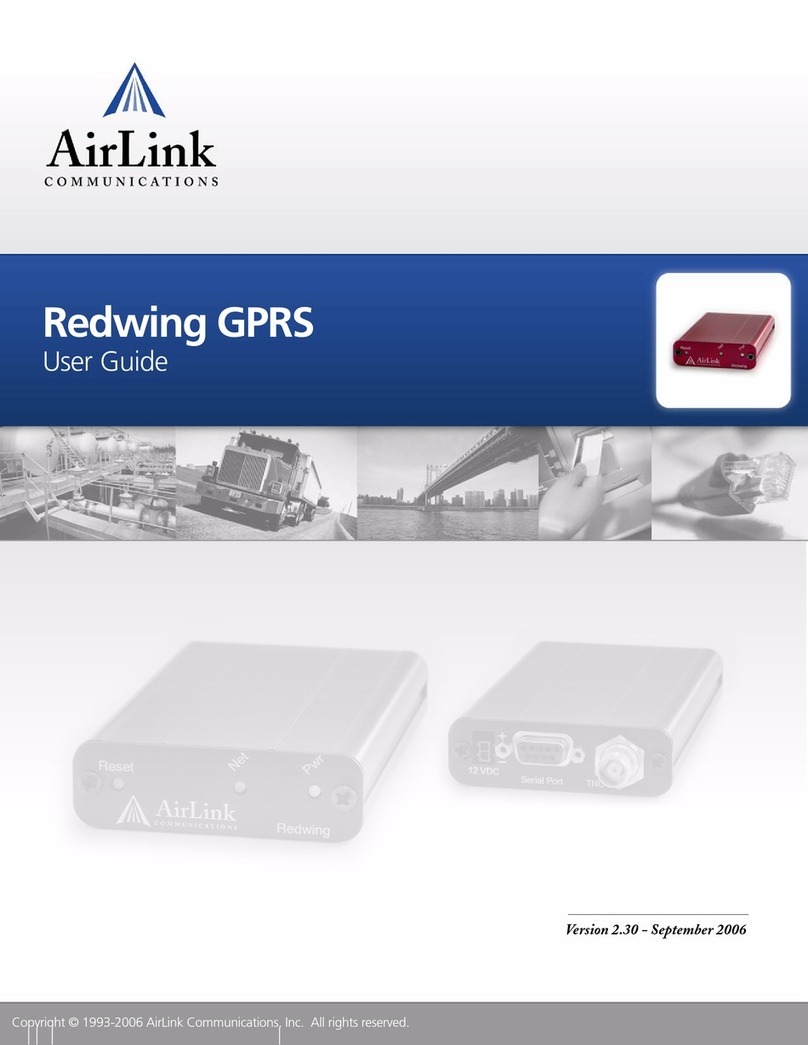
Airlink101
Airlink101 Redwing GPRS user guide
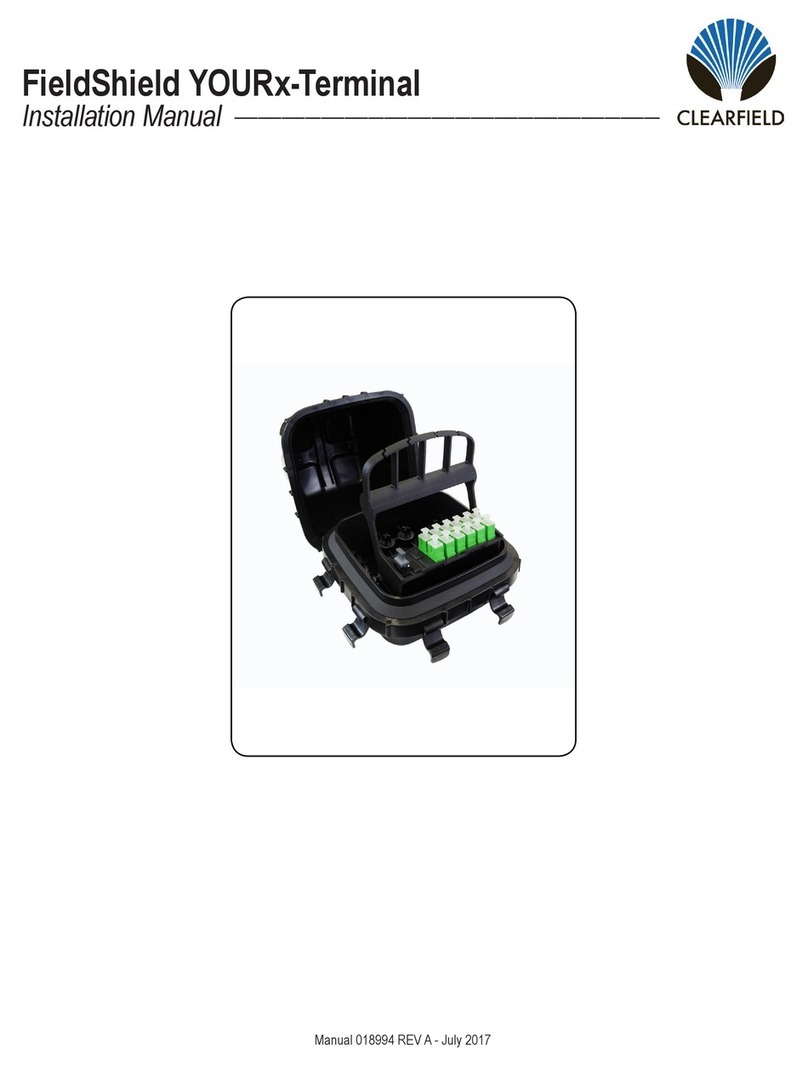
Clearfield
Clearfield FieldShield YOURx-Terminal installation manual
Vicon
Vicon NOVA VI 422 Installation & operation manua

AMG Systems
AMG Systems AMG5904A966G instruction manual
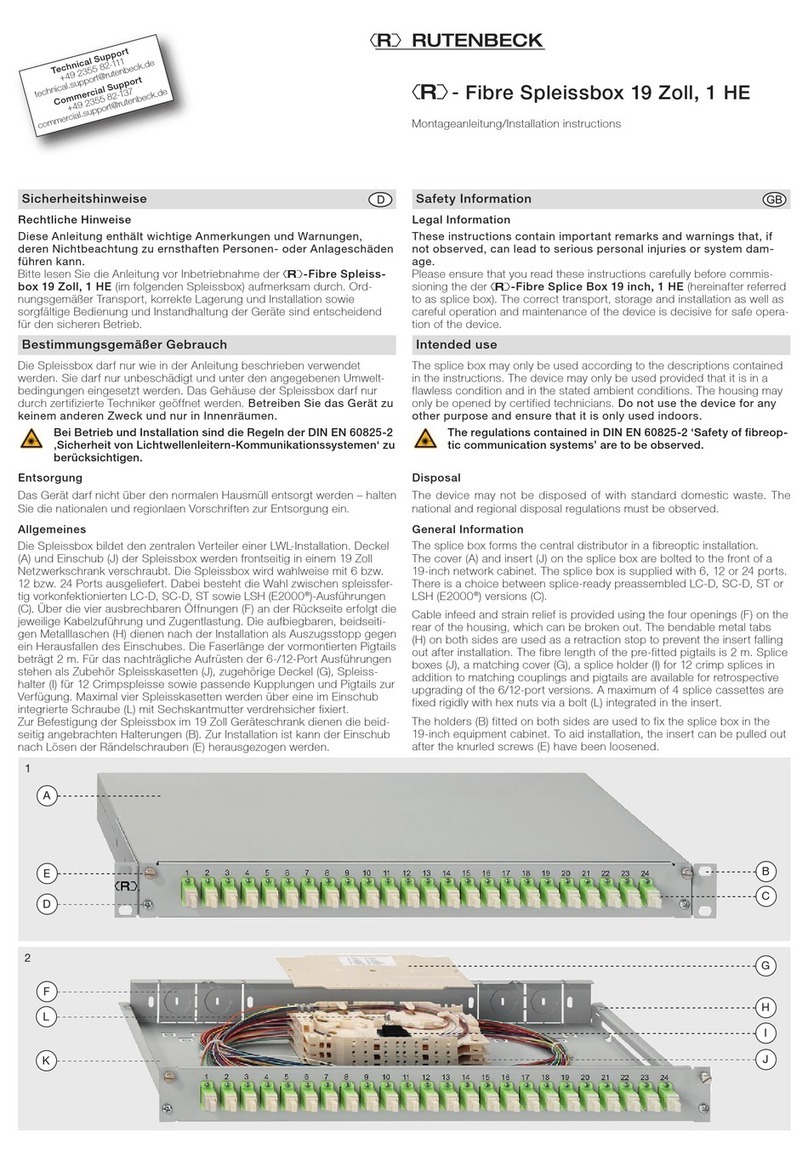
Rutenbeck
Rutenbeck Fibre installation instructions
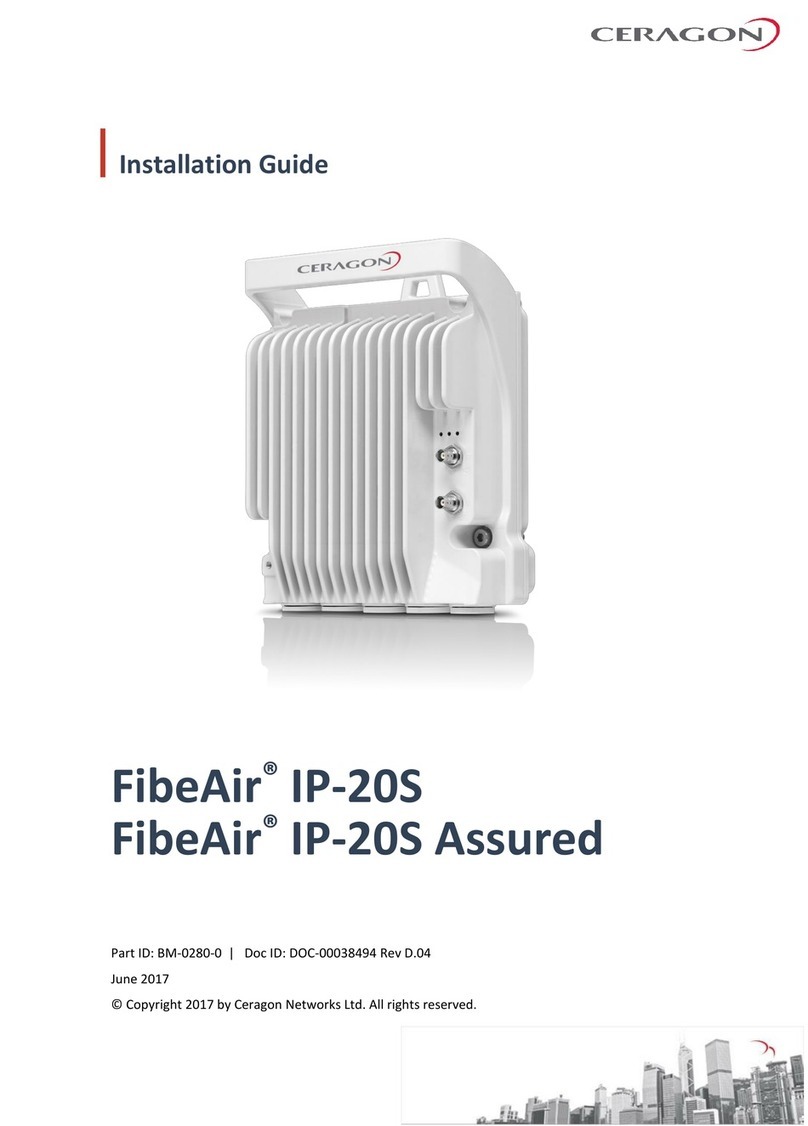
Ceragon
Ceragon FibeAir IP-20S installation guide
